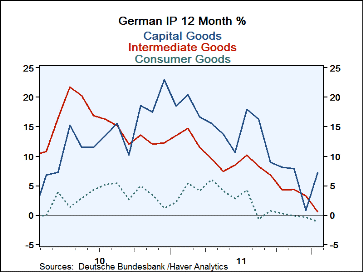 Global| Mar 08 2012
Global| Mar 08 2012German MFG IP Points Mostly Lower
Summary
German industrial production rose by 1.6% in January after falling by 2.6% in December and being flat in November. For the most part industrial trends are pointing lower. Even with the rebound in January the level of IP stands below [...]
 German industrial production rose by 1.6% in January after falling by 2.6% in December and being flat in November.
For the most part industrial trends are pointing lower.
German industrial production rose by 1.6% in January after falling by 2.6% in December and being flat in November.
For the most part industrial trends are pointing lower.
Even with the rebound in January the level of IP stands below the average for Q4. All the sectors are shrinking in Q1 as well except for capital goods and construction. Surprisingly, overall MFG is higher in Q1 compared to Q4 despite weakness in two of its three key sectors.
While German unemployment is at an all-time low since reunification, output is still short of its past cycle; peak. Overall IP is 3.2% below peak, consumer goods output is a larger 6.3% below peak capital goods in only 2.7% below peak and intermediate goods output is 4.4% below peak.
Month-to-month consumer goods output is up by just a tick and capital goods output is up strongly. Intermediate goods output is slightly lower. Over three-months the weakness is more pronounced with only capital goods output higher and consumer and intermediate goods much lower. Still, the rate of descent for IP is not generally getting worse over three-months compared to six months; for the most part it is getting better but it is still weaker over three-months than it is year-over-year by a long shot.
Real MFG orders continue to point lower and they are weakening faster over three months than over six months.
The main surprise feature of this month’s data is the relatively sharp upturn in the output of capital goods. That is not echoed by strength anywhere else in the report except in the construction sector. There, output was up by a sharp 4.3%. That spurt looks less impressive after you notice that IP for construction fell by 6.5% in December. But that series (as is typical) has been very volatile. Construction and capital goods are the leading forces for growth in the nascent first quarter. Even so overall IP is still contracting and MFG alone is barely showing positive growth in Q1. The German outlook remains muddied and tied to the still muddled fortunes of the rollercoaster-Zone.
Robert Brusca
AuthorMore in Author Profile »Robert A. Brusca is Chief Economist of Fact and Opinion Economics, a consulting firm he founded in Manhattan. He has been an economist on Wall Street for over 25 years. He has visited central banking and large institutional clients in over 30 countries in his career as an economist. Mr. Brusca was a Divisional Research Chief at the Federal Reserve Bank of NY (Chief of the International Financial markets Division), a Fed Watcher at Irving Trust and Chief Economist at Nikko Securities International. He is widely quoted and appears in various media. Mr. Brusca holds an MA and Ph.D. in economics from Michigan State University and a BA in Economics from the University of Michigan. His research pursues his strong interests in non aligned policy economics as well as international economics. FAO Economics’ research targets investors to assist them in making better investment decisions in stocks, bonds and in a variety of international assets. The company does not manage money and has no conflicts in giving economic advice.






